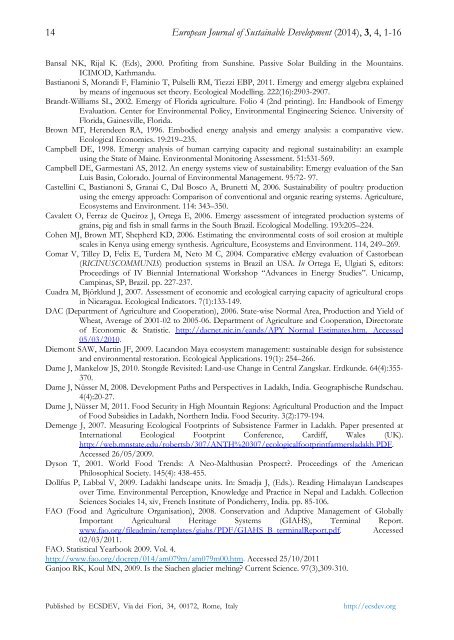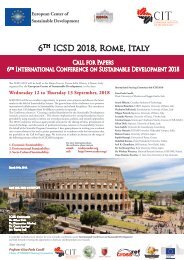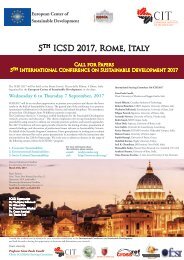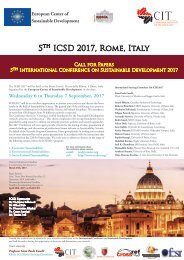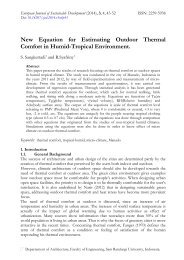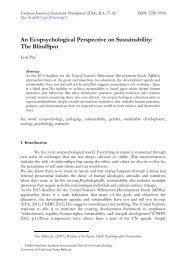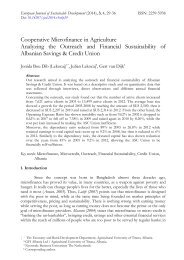Emergy evaluation of a traditional farming system. Case study: Leh District (Ladakh - Indian Trans-Himalaya)
Ladakh traditional farming system has been included on the F.A.O. list of possible “Globally Important Agricultural Heritage Systems”, worthy of being preserved and conserved. The paper describes and assesses cultivation practices in a typical familymanaged farm, located in central Ladakh, analysing how natural resources are exploited, conserved and recycled. Emergy evaluation, an environmental accounting methodology, has been applied to evaluate and compare five staple crop productions: barley, wheat, pea, mustard, and fodder alfalfa. Unit Emergy Values of products (UEV, emergy per unit product, a measure of the environmental production cost) are calculated, taking into account the inputs to production such as water from glaciers, soil fertility, human and animal labour, and more. Results show that the traditional agricultural practices in Ladakh, completely supported by renewable flows, are efficient in the use of local resources. In fact, the UEVs of agroproducts are similar to those of analogous products of conventional agriculture (e.g. 5.27E+05 and 6.64E+05 semj/J for barley and wheat in Ladakh, respectively; 7.37E+05 semj/J for corn in USA), though the inputs of Ladakh agriculture are strongly limited in type and quantity. At the same time, local farmers can create, maintain and rebuild soil functions whose UEV is 1.62E+07 semj/J. Keywords: Ladakh, agrosystem, emergy, environment, sustainability
Ladakh traditional farming system has been included on the F.A.O. list of possible “Globally Important Agricultural Heritage Systems”, worthy of being preserved and
conserved. The paper describes and assesses cultivation practices in a typical familymanaged farm, located in central Ladakh, analysing how natural resources are exploited, conserved and recycled. Emergy evaluation, an environmental accounting methodology, has been applied to evaluate and compare five staple crop productions: barley, wheat, pea, mustard, and fodder alfalfa. Unit Emergy Values of products (UEV, emergy per unit product, a measure of the environmental production cost) are calculated, taking into account the inputs to production such as water from glaciers, soil fertility, human and
animal labour, and more. Results show that the traditional agricultural practices in Ladakh,
completely supported by renewable flows, are efficient in the use of local resources. In fact, the UEVs of agroproducts are similar to those of analogous products of conventional agriculture (e.g. 5.27E+05 and 6.64E+05 semj/J for barley and wheat in Ladakh, respectively; 7.37E+05 semj/J for corn in USA), though the inputs of Ladakh agriculture are strongly limited in type and quantity. At the same time, local farmers can create, maintain and rebuild soil functions whose UEV is 1.62E+07 semj/J.
Keywords: Ladakh, agrosystem, emergy, environment, sustainability
Create successful ePaper yourself
Turn your PDF publications into a flip-book with our unique Google optimized e-Paper software.
14 European Journal <strong>of</strong> Sustainable Development (2014), 3, 4, 1-16<br />
Bansal NK, Rijal K. (Eds), 2000. Pr<strong>of</strong>iting from Sunshine. Passive Solar Building in the Mountains.<br />
ICIMOD, Kathmandu.<br />
Bastianoni S, Morandi F, Flaminio T, Pulselli RM, Tiezzi EBP, 2011. <strong>Emergy</strong> and emergy algebra explained<br />
by means <strong>of</strong> ingenuous set theory. Ecological Modelling. 222(16):2903-2907.<br />
Brandt-Williams SL, 2002. <strong>Emergy</strong> <strong>of</strong> Florida agriculture. Folio 4 (2nd printing). In: Handbook <strong>of</strong> <strong>Emergy</strong><br />
Evaluation. Center for Environmental Policy, Environmental Engineering Science. University <strong>of</strong><br />
Florida, Gainesville, Florida.<br />
Brown MT, Herendeen RA, 1996. Embodied energy analysis and emergy analysis: a comparative view.<br />
Ecological Economics. 19:219–235.<br />
Campbell DE, 1998. <strong>Emergy</strong> analysis <strong>of</strong> human carrying capacity and regional sustainability: an example<br />
using the State <strong>of</strong> Maine. Environmental Monitoring Assessment. 51:531-569.<br />
Campbell DE, Garmestani AS, 2012. An energy <strong>system</strong>s view <strong>of</strong> sustainability: <strong>Emergy</strong> <strong>evaluation</strong> <strong>of</strong> the San<br />
Luis Basin, Colorado. Journal <strong>of</strong> Environmental Management. 95:72- 97.<br />
Castellini C, Bastianoni S, Granai C, Dal Bosco A, Brunetti M, 2006. Sustainability <strong>of</strong> poultry production<br />
using the emergy approach: Comparison <strong>of</strong> conventional and organic rearing <strong>system</strong>s. Agriculture,<br />
Eco<strong>system</strong>s and Environment. 114: 343–350.<br />
Cavalett O, Ferraz de Queiroz J, Ortega E, 2006. <strong>Emergy</strong> assessment <strong>of</strong> integrated production <strong>system</strong>s <strong>of</strong><br />
grains, pig and fish in small farms in the South Brazil. Ecological Modelling. 193:205–224.<br />
Cohen MJ, Brown MT, Shepherd KD, 2006. Estimating the environmental costs <strong>of</strong> soil erosion at multiple<br />
scales in Kenya using emergy synthesis. Agriculture, Eco<strong>system</strong>s and Environment. 114, 249–269.<br />
Comar V, Tilley D, Felix E, Turdera M, Neto M C, 2004. Comparative eMergy <strong>evaluation</strong> <strong>of</strong> Castorbean<br />
(RICINUSCOMMUNIS) production <strong>system</strong>s in Brazil an USA. In Ortega E, Ulgiati S, editors:<br />
Proceedings <strong>of</strong> IV Biennial International Workshop “Advances in Energy Studies”. Unicamp,<br />
Campinas, SP, Brazil. pp. 227-237.<br />
Cuadra M, Björklund J, 2007. Assessment <strong>of</strong> economic and ecological carrying capacity <strong>of</strong> agricultural crops<br />
in Nicaragua. Ecological Indicators. 7(1):133-149.<br />
DAC (Department <strong>of</strong> Agriculture and Cooperation), 2006. State-wise Normal Area, Production and Yield <strong>of</strong><br />
Wheat, Average <strong>of</strong> 2001-02 to 2005-06. Department <strong>of</strong> Agriculture and Cooperation, Directorate<br />
<strong>of</strong> Economic & Statistic. http://dacnet.nic.in/eands/APY_Normal_Estimates.htm. Accessed<br />
05/03/2010.<br />
Diemont SAW, Martin JF, 2009. Lacandon Maya eco<strong>system</strong> management: sustainable design for subsistence<br />
and environmental restoration. Ecological Applications. 19(1): 254–266.<br />
Dame J, Mankelow JS, 2010. Stongde Revisited: Land-use Change in Central Zangskar. Erdkunde. 64(4):355-<br />
370.<br />
Dame J, Nüsser M, 2008. Development Paths and Perspectives in <strong>Ladakh</strong>, India. Geographische Rundschau.<br />
4(4):20-27.<br />
Dame J, Nüsser M, 2011. Food Security in High Mountain Regions: Agricultural Production and the Impact<br />
<strong>of</strong> Food Subsidies in <strong>Ladakh</strong>, Northern India. Food Security. 3(2):179-194.<br />
Demenge J, 2007. Measuring Ecological Footprints <strong>of</strong> Subsistence Farmer in <strong>Ladakh</strong>. Paper presented at<br />
International Ecological Footprint Conference, Cardiff, Wales (UK).<br />
http://web.mnstate.edu/robertsb/307/ANTH%20307/ecologicalfootprintfarmersladakh.PDF.<br />
Accessed 26/05/2009.<br />
Dyson T, 2001. World Food Trends: A Neo-Malthusian Prospect. Proceedings <strong>of</strong> the American<br />
Philosophical Society. 145(4): 438-455.<br />
Dollfus P, Labbal V, 2009. <strong>Ladakh</strong>i landscape units. In: Smadja J, (Eds.). Reading <strong>Himalaya</strong>n Landscapes<br />
over Time. Environmental Perception, Knowledge and Practice in Nepal and <strong>Ladakh</strong>. Collection<br />
Sciences Sociales 14, xiv, French Institute <strong>of</strong> Pondicherry, India. pp. 85-106.<br />
FAO (Food and Agriculture Organisation), 2008. Conservation and Adaptive Management <strong>of</strong> Globally<br />
Important Agricultural Heritage Systems (GIAHS), Terminal Report.<br />
www.fao.org/fileadmin/templates/giahs/PDF/GIAHS_B_terminalReport.pdf. Accessed<br />
02/03/2011.<br />
FAO. Statistical Yearbook 2009. Vol. 4.<br />
http://www.fao.org/docrep/014/am079m/am079m00.htm. Accessed 25/10/2011<br />
Ganjoo RK, Koul MN, 2009. Is the Siachen glacier melting Current Science. 97(3),309-310.<br />
Published by ECSDEV, Via dei Fiori, 34, 00172, Rome, Italy<br />
http://ecsdev.org


